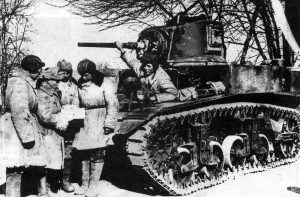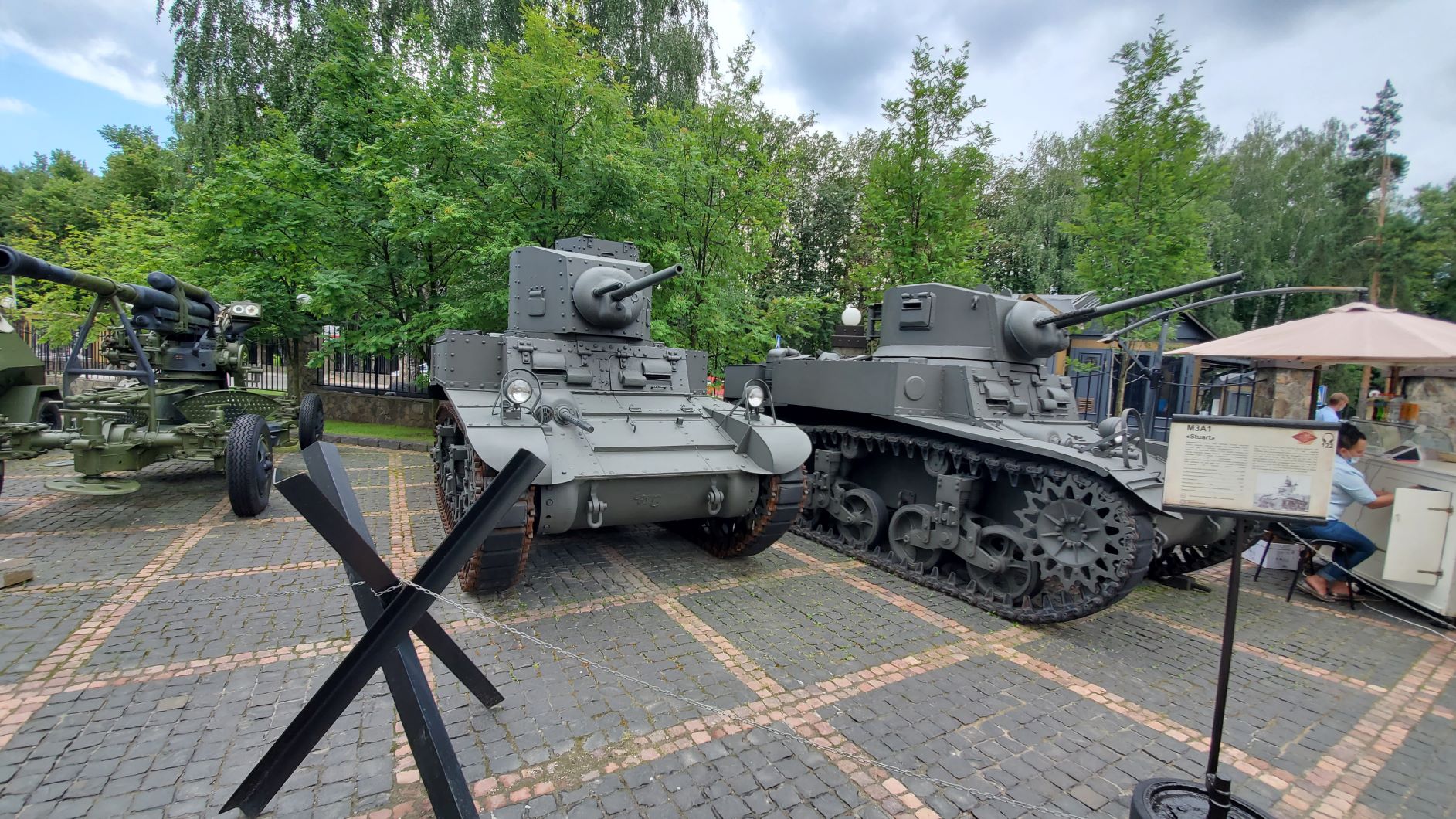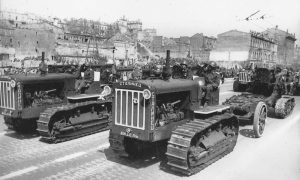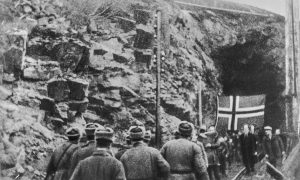M3 Tank- American Light Tank
The M3 was created in 1938-1941 on the basis of the M2 light tank. “Stuart” was mass-produced from March 1941 to June 1944, being repeatedly upgraded during production. A total of 23,685 tanks of this type were built, making the Stuart the most numerous light tank in the history of world tank building.
In World War II, “Stuart” was actively used by US troops , and also in significant quantities supplied under the Lend-Lease program to Great Britain, the USSR, China, the Free French troops and the NOAU . After the war, obsolete by that time, but still numerous “Stuarts” were sold to many other countries, in some of which they were in service until the 1990s .
The history of the “Stewart” begins from the British tank ” Vickers 6-ton”, one of the most common tanks in the world in the interwar period. It was on the basis of its design that the American T5 tank was created in 1933-1934, which became the ancestor of the entire line of serial US light tanks.
The development that led to the creation of the M3 began in 1938, when the experience of the Spanish Civil War showed that the development of small arms made light armored vehicles extremely vulnerable even to conventional infantry weapons, not to mention specialized anti-tank weapons. On April 15, 1938, a meeting was held on the further development of the tank program, at which it was formulated that the M2 light tanks in service with a maximum armor thickness of 15.8 mm are vulnerable to heavy machine gun fire at distances of 700 meters, and in the near future the development of machine guns can increase this distance to 900m. M2 armament, limited to one 12.7 mm and two 7.62mm machine guns were also recognized as completely inadequate, the army clearly needed a qualitatively new machine.
Two other proposals for the layout of the new machine were submitted by Major John K. Christmas in July of that year. The first option was similar to Burns’s proposal, although it weighed two tons more. After revisions, the project received the designation T6 on August 3, 1938 . The only copy of this tank was assembled in June 1939 , but soon all work on this version was discontinued. Development was received by the second project proposed by Christmas – a 10.5-ton tank armed with a 37-mm cannon in a single rotating turret with a 7.62-mm machine gun paired with it, as well as a second machine gun in the frontal sheet of the hull. Tank had driven radial aircraft engine ” Continental “W-670 and be protected by 25mm armor. It was this concept that later served as the starting point for work on the new tank.
The result of the developments was a modification of the light tank M2 – M2A4, launched into production by order of December 29, 1938. The new vehicle was distinguished from its predecessors by a two-man turret equipped with a 37 mm M3A1 cannon and a 7.62 mm machine gun paired with it, vertical armor thickened to 25 mm, and two additional 7.62 mm machine guns in the hull sponsons . From May 1940 to March 1941, 365 tanks of this version were produced, which became the direct predecessor of the M3
The initial version of the future tank, proposed by Lieutenant Colonel G.M.Burns, was distinguished by an extreme simplification and cheapening of the design, caused by the meager funding of the army in those years. According to the plan, it was supposed to be a light 7-ton tank with a crew of two, protected by armor up to 38 mm thick and armed with a 37-mm cannon and a 7.62-mm machine gun, placed in the frontal sheet of the hull . This arrangement made it possible to use many civilian vehicle units in the design of the tank and significantly reduce the cost of the vehicle, but this project was never developed.

Eastern front
The USSR was the second largest recipient of M3s under the Lend-Lease program after Great Britain . The first Stuarts arrived in the USSR in January 1942 and continued to be delivered until April 1943. Almost all of them belonged to modifications M3 and M3A1 (340 M3 and 1336 M3A1 were sent, 1232 tanks reached the USSR, including 211 diesel ones), only 5 M5A1 arrived in 1943, when deliveries were discontinued on the initiative the Soviet side. In the Red Army, the “Stuarts” were called “M3 light” or simply “M3l”. Despite the high driving performance and superiority in the sum of characteristics over mostl Soviet light tanks, with the exception of small – scale T-50 and T-80, M3s did not enjoy much success with tankers. The tanks received in 1942 for the comfort of tankers inside the fighting compartment were covered with spongy rubber, which, when burned, gave off suffocating smoke. The tank was distinguished by its large dimensions, poor armor and especially armament, it was difficult, by Soviet standards, to operate, and the M3 aircraft engine consumed a large amount of scarce high-octane gasoline, and, accordingly, burned like a candle in case of successful enemy fire. In addition, initially only armor-piercing shells were supplied with the Stuarts, which seriously limited the tank’s ability to combat infantry or anti-tank guns.
With the improvement of the situation with the number of tanks by 1943, “Stuarts” were mainly replaced in the troops by more powerful machines, but some units continued to use them until 1945. Nevertheless, the M3 tanks were used by the Red Army very actively, practically on all fronts. Many “Stuarts” fought on the North Caucasian and Transcaucasian fronts (the proximity to the Iranian supply route), tanks of this type participated in the battles of the Western Front in the Rzhev-Sychev direction in 1942. In February 1943, the 563rd Tank Battalion separate from M3l participated in the landing of troops in South Ozereyka under Novorossiysk(the only Soviet landing operation, during which tanks landed in the first wave of the landing); Of the 30 tanks that participated in the landing, most were destroyed during the landing, but 8 tanks were able to go ashore and fought for several days until they were knocked out. These tanks also fought on the North-Western Front (as of February 1943, two tank regiments had 27 M3l). M3L appeared in the Voronezh Front in the summer of 1942, and by the beginning of the Battle of Kurskthe 245th separate tank regiment and the 192nd tank brigade had 51 tanks of this type. Interestingly, the M3L tanks became the first Soviet tanks to engage the Germans in the battle on the Kursk Bulge – on the night of July 4-5, the tanks of the 245th separate tank regiment took over the attack of German troops, and on July 11, the M3L and M3s of this regiment took part in the Prokhorov battle . One “Stuart” in the Trans-Baikal Front participated in 1945 in hostilities against Japan.













Pingback: FlaK 88mm, 18/36/37 Anti-Aircraft Gun - Real History Online